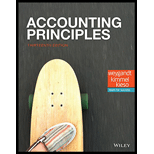
Concept explainers
(a)
Accounts payable: The accounts payable is a liability account and it records the amount which is due by the business to the suppliers.
To determine: The ending balance of accounts payable.
(b)
To determine: the ending balance of accounts receivable.
(c)
Cash: The cash account is an asset account which is held by the business to pay off its liabilities and expenses.
To determine: the ending balance of cash
(d)
Inventory: Inventory account is an asset account and it refers to the raw materials, work-in-progress and the finished goods in the business.
To determine: the ending balance of inventory.
(e)
Sales revenue: The sales revenue is an asset account and it records the income from the sale of goods and services.
To determine: the ending balance of sales revenue.
Want to see the full answer?
Check out a sample textbook solution
Chapter 7 Solutions
EBK ACCOUNTING PRINCIPLES
- Westlake Components planned to use $95 of material per unit but actually used $92 of material per unit. The company planned to produce 1,800 units but actually produced 1,400 units. What is the sales-volume variance?arrow_forwardPlease provide the answer to this general accounting question with proper steps.arrow_forwardNavarro Enterprises has a beginning retained earnings balance of $78,000. Net income for the year is $22,000, and cash dividends paid during the year amount to $12,500. What will be the ending retained earnings balance? a. $78,000 b. $87,500 c. $100,000 d. $65,500arrow_forward
- Determine the pre-paid insurance value for portman enterprises as this is the one unknown item.arrow_forwardCornell Corporation plans to generate $960,000 of sales revenue if a capital project is implemented. Assuming a 30% tax rate, the sales revenue should be reflected in the analysis by:arrow_forwardYour factory produces 165 electric bicycles per month. Direct costs are $1,890 per bicycle. The monthly overhead is $92,400. What is the average cost per electric bicycle with overhead?arrow_forward
- How does principle-based accounting differ from rule-based systems? (a) Detailed regulations cover every situation (b) Strict numerical thresholds determine all treatments (c) Professional judgment guides decisions rather than strict rules (d) Standard formulas solve all problems. MCQarrow_forwardI need help with this financial accounting question using standard accounting techniques.arrow_forwardPlease provide the solution to this general accounting question using proper accounting principles.arrow_forward

 AccountingAccountingISBN:9781337272094Author:WARREN, Carl S., Reeve, James M., Duchac, Jonathan E.Publisher:Cengage Learning,
AccountingAccountingISBN:9781337272094Author:WARREN, Carl S., Reeve, James M., Duchac, Jonathan E.Publisher:Cengage Learning, Accounting Information SystemsAccountingISBN:9781337619202Author:Hall, James A.Publisher:Cengage Learning,
Accounting Information SystemsAccountingISBN:9781337619202Author:Hall, James A.Publisher:Cengage Learning, Horngren's Cost Accounting: A Managerial Emphasis...AccountingISBN:9780134475585Author:Srikant M. Datar, Madhav V. RajanPublisher:PEARSON
Horngren's Cost Accounting: A Managerial Emphasis...AccountingISBN:9780134475585Author:Srikant M. Datar, Madhav V. RajanPublisher:PEARSON Intermediate AccountingAccountingISBN:9781259722660Author:J. David Spiceland, Mark W. Nelson, Wayne M ThomasPublisher:McGraw-Hill Education
Intermediate AccountingAccountingISBN:9781259722660Author:J. David Spiceland, Mark W. Nelson, Wayne M ThomasPublisher:McGraw-Hill Education Financial and Managerial AccountingAccountingISBN:9781259726705Author:John J Wild, Ken W. Shaw, Barbara Chiappetta Fundamental Accounting PrinciplesPublisher:McGraw-Hill Education
Financial and Managerial AccountingAccountingISBN:9781259726705Author:John J Wild, Ken W. Shaw, Barbara Chiappetta Fundamental Accounting PrinciplesPublisher:McGraw-Hill Education





